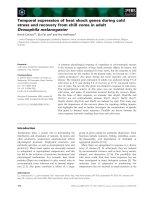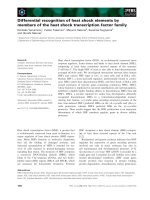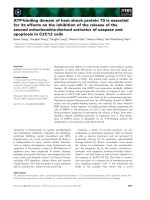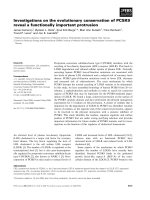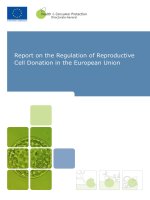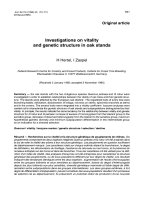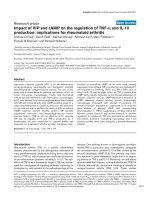Investigations on the roles of ubiquitin in the regulation of heat shock gene HSP70B 2
Bạn đang xem bản rút gọn của tài liệu. Xem và tải ngay bản đầy đủ của tài liệu tại đây (189.94 KB, 16 trang )
i
Acknowledgements
I would like to thank the following people for making this thesis possible.
My supervisor Assistant Professor Norbert Lehming for his invaluable insight and guidance.
My mentor Miss Tan Yee Sun for her patience, concern and instruction.
The staff in the lab, past and present for their professionalism, constant advice and support;
Madams Chew Lai Ming, Cecilia Yang Caixin, Misses Siew Wee Leng, Nguyen Khahn Linh.
Tay Ywee Chieh, Lim Mei Kee and Mister Leo Lim Mun Kuan.
My fellow graduate students for all the camaraderie, aid and admittedly a certain degree of
shared schandenfreude: Doctors Chew Boon Shang, He Hong Peng, Xue Xiaowei, Misses Zhao
Jin, Vivian Tang Hui Ming, Rashmi Triparthi, Linda Lee Shu Yi and Mister Keven Ang Kue-
Loong
All the undergraduate students who have passed through the lab’s doors for their friendship and
helping me understand that it is by teaching that we truly learn. Madams Wong Seong Leng,
Rachel Anne Therese Teo Shi Hui, Misses Yu Jia, Chan Yu Mun, Karen Naduas, Celeste Lau,
Nur Sabrina bte Sapari, Lim Hui Kheng, Wu Mei Hui, Agnes Chia Yi Fang, Yeo Jia Hui, Nafiza
bte Ahmad, Misters Benjamin Xiao Junwen Daniel Wu Zheng’An, Sun Weiqi, Edwin Ang Lee
Keong and Elvin Koh Wei Chuan.
Special mention to Jason Goo Kian Sim for being the de facto “big brother” to all the other
graduate students. Also to all the great people in the other labs on MD4 level 1 that I had the
privilege to work with. It would have been a much harder road without you all.
ii
Table of Contents
Title
Page
Chapter 1: Introduction
1
1.1: The Process and Mechanisms of Transcription
1
1.1.1 Introduction to Transcription and the Transcriptional Machinery
1
1.1.2 The Eukaryotic Transcriptional Machinery
2
1.2 The Mediator Complex
6
1.2.1 Introduction to the Mediator Complex
6
1.2.2 Structure and Function of the Mediator Complex
7
1.3 The Ubiquitin Proteosome System
10
1.3.1 The Discovery of the Ubiquitin Proteomsome System
10
1.3.2 The Structure and Function of the 26S Proteosome
13
1.3.3 The Machinery and Process of Ubiquitination in Brief
16
1.3.4 E4 Ubiquitin Ligases in the Elongation of Polyubiquitin Chains
19
1.3.5 Ubiquitin-Proteosome Adaptors
23
1.4 The Non-proteolytic Roles of Ubiquitin
24
iii
1.4.1 An Introduction to the Role of Ubiquitin as a Signaling Molecule
24
1.4.2 Ubiquitin as a Signaling Molecule in the Regulation of Transcription Factors
24
1.4.3 An Introduction to Mono-ubiquitination as a Signaling Molecule
26
1.4.4 Ubiquitin as a Mediator of Protein Interaction
28
1.4.5 Ubiquitin in the Regulation of Endocytosis and Intercellular Trafficking
29
1.4.6 Ubiquitin’s Role in DNA Repair
33
1.4.7 Signaling by Ubiquitin-like Molecules
34
1.5 The Role of Mediator, Ubiquitin and the Proteosome in Transcriptional Regulation
38
1.5.1 Introduction to Transcriptional Regulation in Eukaryotes
38
1.5.2 Mediator Complex in Transcriptional Regulation
39
1.5.3 The Role of Ubiquitin in Transcriptional Regulation
40
1.5.4 The Proteolytic Role of the Proteosome in the Regulation of Transcription
42
1.5.4 The Non-Proteolytic Role of the Proteosome in the Regulation of Transcription
47
1.5.6 The Role of Ubiquitin and the Proteosome System Acting in Unison in
Transcriptional Regulation
52
1.5.7 Common Components of the Transcriptional Machinery and the Ubiquitin
Proteosome System
55
iv
1.6 Theoretical Basis and Systemic Objectives of This Study
57
Chapter 2: Materials and Methods
58
2.1 Molecular Tools for the Expression of Proteins
58
2.1.1 Cloning of Tagged Constructs into Vectors
58
2.1.2 Cloning Stategies
59
2.1.3 Polymerase Chain Reaction (PCR)
59
2.1.4 Cloning of Gene into Vectors
60
2.1.5 Transformation and Inoculation
60
2.1.6 Low-yield Purification of Plasmid DNA (Miniprep)
61
2.1.7 Qualification of Miniprep product
62
2.1.8 DNA Sequencing
62
2.2 Synthesis of Constructs for RNA Interference of hSKP1 and hSRB7/MED21
63
2.2.1 Design of siRNA pSuper Constructs
63
2.2.2 Annealing of Constructs
63
2.3 Transfection of High Quality Plasmids into HeLa Cells
64
v
2.3.1 Retransformation
65
2.3.2 Medium-yield Purification of Plasmid DNA (Midi-prep)
65
2.3.3 Transfection of Plasmids into Human Cells
67
2.4 Tools for the Identification, Purification and Visualization of Proteins
70
2.4.1 Purification of GST and MYC-tagged constructs
70
2.4.2 Coimmunoprecipitation of Mediator and SCF Components
71
2.4.3 Western Blot
72
2.4.4 Stripping Western Blots
76
2.4.5 Split-ubiquitin Screens
76
2.5 Tools for mRNA Extraction and Quantification
78
2.5.1 Transfection of siRNA constructs and Treatments Prior to mRNA Isolation
78
2.5.2 Isolation of mRNA
78
2.5.3 DNAaseI Treatment and Reverse Transcription
80
2.5.4 Real-Time Quantative PCR
81
2.6 Chromatin Immunoprecipitation
83
vi
Chapter 3: Results
86
3.1 Introduction to Skp1 and Relevant Molecular Tools
86
3.2 HSP70B’ as an Inducible Gene for Study
92
3.3 The Effects of Skp1 Depletion on HSP70B’ Expression
96
3.4 Proteosomal Inhibition of HSP70B’ and its Interaction With siSkp1
99
3.5 Srb7 as an Interacting Partner of Skp1
104
3.6 The Role of Med21/hSrb7 in the Regulation of HSP70B’
109
3.7 The Effect of the RNA Interference of Med21/hSrb7 and its Effects on
Proteosomal Inhibition of HSP70B’ Induction
113
3.8 The Interaction between Skp1 and Mediator Components
118
3.9 The Interaction between Med6 and Cul1
121
3.10 Molecular Tools Concerning Hsf1
130
3.11 The Effect of siHSF1 on HSP70B’ Induction
133
3.12 Determining the Existence of Ubiquitinated Species of Hsf1
137
3.13 The Stability of Hsf1
141
3.14 The Presence of Hsf1 at the HSP70B’ Promoter
149
vii
Chapter 4: Discussion
158
4.1 Key Findings of the Project
158
4.2 The Regulation of HSP70B’ and its Relevance to Human Health and Disease
159
4.3 Proteosome Inhibitors and Hsp70B’
164
4.4 The Regulation of HSP70B’ by Hsf1
167
4.5 The Role of Hsf1 in Human Health and Disease
173
4.6 Conclusion
176
Bibliography
177
References
177
Websites
197
Appendix
198
Common Stock Solutions
198
Publications
198
viii
Summary
Transcription is one of the most fundamental processes in a living cell and as such, it is no
surprise that it is tightly regulated on many levels. The post-translational modification of
transcription factors is one means by which the cell achieves transcriptional regulation. Of
particular interest to us is the ubiquitination of transcription factors. Ubiquitin traditionally
serves as a proteolytic signal in the form of K48 polyubiquitin chains that are recognized by the
26S proteosome. However it is now accepted that mono-ubiquitin as well as K63 polyubiquitin
chains are both signaling motifs outside of the context of proteosomal degradation (Hicke et al.,
2005). Each of these modifications has their role in the regulation of transcription.
In this project we investigated the role of ubiquitin in the regulation of the heat shock gene
HSP70B’. Through RNA interference of SKP1, a component of an ubiquitin ligase (Zhou, et al.,
1998), we demonstrated that the loss of ubiquitination can severely reduce the induction of
HSP70B’ by heat shock. However this effect is not necessarily the result of a loss of proteosomal
degradation affecting a transcription factor. The application of a proteosome inhibitor induces
the expression of HSP70B’ and RNA interference of SKP1 likewise can reduce this increase in
expression. This would imply that ubiquitination signaling, rather than proteosomal degradation,
is a key factor in the regulation of HSP70B’.
Split-ubiquitin screens performed to discover if Skp1 has interacting partners outside of its native
ubiquitin ligase complex found that Mediator component Srb7 interacts with Skp1 in vitro. In
ix
vivo evidence for this interaction was found in a co-immunoprecipitation where human Skp1
could immunoprecipitate Med21, the human homologue of Srb7, and vice versa. RNA
interference of MED21 could reduce the induction of HSP70B’ by heat shock or proteosomal
inhibition much in the same manner as RNA interference targeted at SKP1 did. This implies a
functional relationship between these proteins in the regulation of HSP70B’. Co-
immunoprecipitation experiments showed that components of the SCF (Skp1-Cullin-F-box
protein) complex that Skp1 belongs to can immunoprecipitate components of the Mediator
Complex and that the reverse is also true. This could indicate that these two complexes have a
hereinto uncharacterized relationship in the regulation of transcription.
Subsequent investigations found that the heat shock transcription factor Hsf1 is a regulator of
HSP70B’ expression; RNA interference targeted at HSF1 causes a strong reduction in HSP70B’
induction that can be ameliorated by the application of proteosome inhibitor. Co-
immunoprecipitation experiments demonstrated that Hsf1 has abundant ubiquitinated species in
vivo. Overall our data favors a model where ubiquitination is a moiety that activates the
transcription factor Hsf1 to drive HSP70B’ expression. Over time, this ubiquitinated Hsf1 is
polyubiquitinated and degraded, limiting its active lifespan which accounts for the activity of
both proteosome inhibitors and siRNA targeted at SKP1. Our findings have great relevance to
human health and disease; the regulation of heat shock proteins and Hsf1 implicated in various
diseases (Khaleque et al., 2005) while a proteosome inhibitor is used in chemotheraphy (San
Miguel et al., 2008). (500 words)
x
List of Tables
Table
Page
Table 1: DNA and LipofectANIME Ratios for Transfection
69
Table 2: Western Blot Primary and Secondary Antibodies
75
Table 3: Primers Used for ChIP
85, 152
List of Figures
Figure
Page
Figure 1: Immunoprecipitation of Skp1 with Endogenous Antibody and Protein G
Sepharose Beads
87
Figure 2: MYC-hSkp1 is Expressed in the Cell
88
Figure 3: Immunoprecipitation of Skp1 with Endogenous Antibody and Protein G
Sepharose Beads
89
Figure 4: Knockdown of Skp1 by a pSuper construct
90
Figure 4.1: Quantification of “Knockdown of Skp1 by a pSuper construct”
91
Figure 5: Measurement of HSP90 and HSP70B’ Heat Induction
94
Figure 6: siRNA Treatment Can Reduce the Expression of SKP1
95
Figure 7: siSKP1 Treatment Reduces HSP70B’ Induction Upon Heat-shock
96
xi
Figure 8: hSkp1 siRNA Can Affect the Induction of HSP70B’ By MG132
100
Figure 9: MG132 Treatment Induces HSP70B’ In Addition to Heat-shock
102
Figure 10 hSkp1 siRNA Can Affect the Induction of HSP70B’
103
Figure 11: A Split-Ubiquitin Screen identified hSkp1p as a hSrb7p-interacting Protein
106
Figure 12: hSkp1 Interacts with hSrb7 in vitro
108
Figure 13: siRNA Treatments Can Reduce the Expression of MED21
110
Figure 14: siMED21 Treatment Reduces HSP70B’ Induction Upon Heat-shock
111
Figure 15: GAPDH Ct Values Reflect No General Transcription Defect in the Cell
112
Figure 16: siMED21 Can Affect the Induction of HSP70B’ By MG132
113
Figure 17: siMED21 Can Affect the Induction of HSP70B’
114
Figure 18: Co-immunoprecipitation of Med6 by MYC-Skp1 using MYC-tagged Beads
120
Figure 19: Immunoprecipitation of hCul1
122
Figure 20: Immunoprecipitation of hMed6
123
Figure 21: Co-immunoprecipitation of Cul1 by Med6 with Protein A and Protein G
124
Figure 22: Co-immunoprecipitation of Med6 by Cul1 with Protein A and Protein G
125
Figure 23: siRNA Treatment Has Only Modest Effect on Hsf1 Expression
130
xii
Figure 23.1: Quantification of “siRNA Treatment Has Only Modest Effect on Hsf1
Expression”
131
Figure 24: The Expression of HSF1 Can Be Reduced by siRNA Treatment
132
Figure 25 siHSF1 Can Lower the Induction of HSP70B’ After Proteosome Inhibition
133
Figure 26: siHSF1 Can Lower the Induction of HSP70B’ After Heat Shock
134
Figure 27: Immunoprecipitation of ubiquitinated Hsf1 with α-Hsf1 and Protein A/G
138
Figure 28: Immunoprecipitation of ubiquitinated Hsf1 by α-Ub and Protein G
139
Figure 29: ChIP Targeting the HSP70B’ Promoter using MYC-Skp1
140
Figure 30: Hsf1 is Stable in a 37°C Cycloheximide Chase
142
Figure 30.1: Cul1 as a Loading Control for Hsf1 Stability
142
Figure 30.2: Quantification of “Hsf1 is Stable in a 37°C Cycloheximide Chase”
143
Figure 31: Hsf1 is Stable in a 37°C Cycloheximide Chase
144
Figure 32: Excessive Heat Shock Leads to Degradation of Hsf1
146
Figure 32.1: Cul1 as a Loading Control for Hsf1 Stability
146
Figure 32.2: Quantification of “Excessive Heat Shock Leads to Degradation of Hsf1”
147
Figure 33:Crosslinking Leads to Loss of Protein Signal
150
Figure 34: HSP70B’ Promoter
152
xiii
Figure 35: ChIP of Ubiquitinated Hsf1 Shows No Promoter Occupancy at HSP70B’
Promoter
153
Figure 36: ChIP Sample DNA Concentration (ng/µL)
157
List of Illustrations
Illustration
Page
Illustration 1: Transcription Preinitiation Complex Assembly
3
Illustration 2: Ubiquitin Proteosome System
17
Illustration 3: Split Ubiquitin System
77
Illustration 4: Hypothetical Model of HSP70B’ Regulation
171
List of Symbols
None
List of Conventions
Gene name with only first letter capitalized, i.e.
Hsf1
Protein
Gene name entirely capitalized, i.e. HSF1
Protein; often an abbreviation, complex or
compound name
xiv
Gene name entirely capitalized and italicized,
i.e. HSF1
Gene or mRNA
α-[protein name]
Antibody specific for the named protein
si[gene name]
Small interfering RNA construct specific for
the named gene’s mRNA
h[protein name or gene name]
Refers to a human protein or gene; used to
distinguish between Saccharomyces cerevisiae
and Homo Sapiens proteins or genes when both
are relevant to the discussion at hand
List of Common Abbreviations
All abbreviations used are explained in the text but this table contains some of the most
commonly used abbreviations for ease of reference.
APIS
The 19S ATPase proteins independent of 20S
Complex
ATP
Adenosine Triphosphate
CHIP
C-terminus of Hsc70-interacting protein
ChIP
Chromatin Immunoprecipitation
CIITA
Class II Transactivator
xv
CTD
C-terminal Domain
DNA
Deoxyribonucleic Acid
DUB
Deubiquitinating Enzyme
GAPDH
Glyceraldehyde-3-phosphate Dehydrogenase
GST
Glutathione-S-Transferase
HA
Haemagglutinin
HAT
Histone Acetyltransferase
HDAC
Histone Deacetylase
HRP
Horseradish Peroxidase
HSE
Heat Shock Element
MHCII
Major Histocompatability Class II
mRNA
Messenger Ribonucleic Acid
MYC
Epitope derived from the c-MYC gene
xvi
PBS
Phosphate Buffered Saline
PCR
Polymerase Chain Reaction
RNA
Ribonucleic Acid
RT qPCR
Reverse Transcription-coupled Quantative
Real-time PCR
SCF Complex
Skp1 - Cullin - F-box Protein Complex
siRNA
Short interfering Ribonucleic Acid
Ub
Ubiquitin
UBD
Ubiquitin-binding Domain
UBP
Ubiquitin Protease
UPS
Ubiquitin Proteosome System
USP
Ubiquitin Specific Protease


